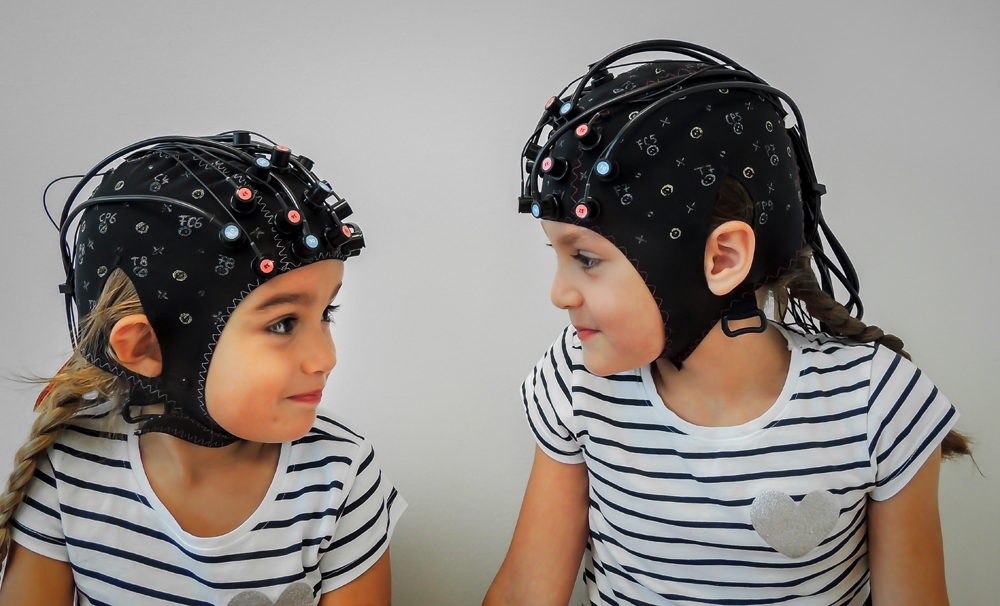fNIRS in Infant and Child Studies
fNIRS is an ideal technology to research child and infant brain activity. Considering the modality's noninvasive and light-weight nature, as well as its fast setup and preparation time, it is a very well tolerated method. NIRx has optimized our solutions to maximize the technologies’ capabilities to help you be successful in your research.
fNIRS has been used to address speech perception and language development, social communication and interaction, object processing, human action processing, developmental disorders and more. After listening and working with the leaders in the field, we innovated anatomically appropriate comfortable caps. We also have anatomically correct head models implemented throughout the planning and recording software.
Since the pioneering studies of functional brain activation in infants, the number of published fNIRS infant and child studies has rapidly increased. High impact publications cover a wide range of research topics such as speech perception, language development, social communication, interaction, object processing amongst others.
…with NIRx
Two leading research platforms the NIRScout (lab-based) and NIRSport (mobile)
Premium software solutions like Satori
Extra features that such as accelerometer, short-channels and a specialized physiological sensor module.
Advantages of fNIRS…
Fast setup time of <1 minute
Robust to motion and environmental noise
Completely non-invasive (no tracer or gel needed)
High-resolution results (~1-3 cm)
Easily combined with other modalities: eye-tracking, EEG, etc.
Technology is silent and non-constraining
NIRx Specialized Optodes for Child and Infant Imaging
NIRx offers fNIRS a reliable, easy-to-use, and efficient technology to research the infant and child brain.
The NIRx blunt-tipped optode is ideal for neonatal and infant subjects.
Short distance channels for participants older than 10 years.
The NIRx patented dual-tipped optode is ideal for subjects ages 1 – adult.
There have been over 1000 publications with our systems, check out more papers on this page or view the selected child and infant research below.
+ Selected Publications
Camacho, M. C., Williams, E. M., Ding, K., & Perlman, S. B. (2021). Multimodal Examination of Emotion Processing Systems Associated with Negative Affectivity across Early Childhood. Developmental Cognitive Neuroscience, 100917.
Galderisi, A., Brigadoi, S., Cutini, S., Moro, S. B., Lolli, E., Meconi, F., ... & Dell’Acqua, R. (2016). Long-term continuous monitoring of the preterm brain with diffuse optical tomography and electroencephalography: a technical note on cap manufacturing. Neurophotonics, 3(4), 045009.
Krol, K. M., Namaky, N., Monakhov, M., San Lai, P., Ebstein, R., & Grossmann, T. (2021). Genetic variation in the oxytocin system and its link to social motivation in human infants. Psychoneuroendocrinology, 131, 105290
McKay, C. A., Shing, Y. L., Rafetseder, E., & Wijeakumar, S. (2021). Home assessment of visual working memory in pre‐schoolers reveals associations between behaviour, brain activation and parent reports of life stress. Developmental Science, e13094.
Cabrera, L., & Gervain, J. (2020). Speech perception at birth: The brain encodes fast and slow temporal information. Science Advances, 6(30), eaba7830.
Mazaika, P. K., Marzelli, M., Tong, G., Foland‐Ross, L. C., Buckingham, B. A., Aye, T., & Reiss, A. L. (2020). Functional near‐infrared spectroscopy detects increased activation of the brain frontal‐parietal network in youth with type 1 diabetes. Pediatric Diabetes, 21(3), 515-523.
de Oliveira, S. R., Machado, A. C. C. P., de Paula, J. J., Novi, S. L., Mesquita, R. C., de Miranda, D. M., & Bouzada, M. C. F. (2019). Changes of functional response in sensorimotor cortex of preterm and full-term infants during the first year: An fNIRS study. Early Human Development, 133, 23–28.







